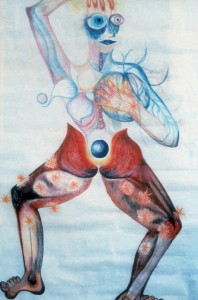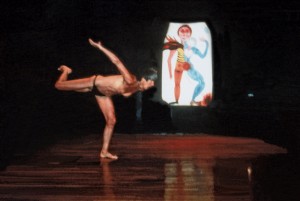Learn about the self-portrait dance – An interpretation of oneself through drawings of the individual components of the body. Merging them together allows you to see the image you have of yourself brought about by your subconscious. When combined with dance, the mind and body can connect and begin to raise questions about this image.
For more on the life and works of Anna Halprin, see Gabriele Wittmann’s book ‘Anna Halprin – Dance – Process – Form’
THE SELF-PORTRAIT DANCE
The perceptual journey through the body, accompanied by Movement Ritual and psychokinetic visualisation, can be followed through images, texts and episodic dance. Visualisations of different areas of the body – the head, spine, ribcage, shoulder girdle, abdomen and pelvis, arms and hands, legs and feet – finally come together in the drawing of a life-size self-portrait in which the separate images fit together in one large whole. Daria Halprin says: ‘Thinking of the body as a family made up of separate yet interrelated members, we know that each part has an impact on the whole and that each part can help us understand the whole. When a family is in conflict, it is important to listen to each member separately as well as listening to how they communicate with one another so that we can really hear and understand.’36 As if in a mirror, the person who did the drawing sees and encounters herself in the image she has created, and embarks on the journey of deciphering the messages concealed in it. She approaches the image not as one who knows, but as one asking questions. Anna Halprin drew a self-portrait and transposed the image into dance when she was coming to terms with her cancer diagnosis, of which she writes:
‘This process of connecting with our internal imagery involved “dancing” the images that welled up from the unconscious as another way of connecting the mind and the body. In learning this imagistic language, it became clear I was receiving messages from an intelligence within the body, an intelligence deeper and more unpredictable than anything I could understand through rational thought.’ Various pathways open up as one approaches one’s self-portrait. The person who drew it lets the entire image, or aspects of it, speak to them and tries to hear, see and feel its messages (see Figure 18). The selfportrait is asked questions: Where are you from? Where are you going?
Answers come out of the silent dialogue, from the ‘soul’ of the image.38 In creative writing, texts and dialogues emerge between different forms and figures inthe image. They open up the gaze and the senses to the hidden, mysterious, unknown and seemingly alien, and blend together in a life story of the self-portrait. Processes of developing a concluding performance are walked through, following the model of RSVP Cycles (described below). The emotional process of discovery follows the thread of the Five-Part Process on the way to integrating the experiences gained.
For more on the life and works of Anna Halprin, see Gabriele Wittmann’s book ‘Anna Halprin – Dance – Process – Form’

